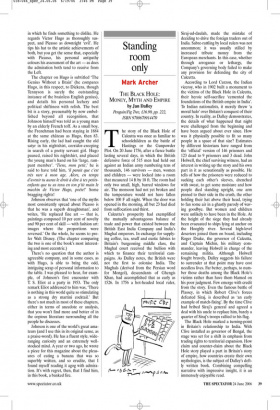Standing room only
Mark Archer
THE BLACK HOLE: MONEY, MYTH AND EMPIRE by Jan Dalley Penguin/Fig Tree, £16.99, pp. 222, ISBN 9780670914470 The story of the Black Hole of Calcutta was once as familiar to schoolchildren as the battle of Hastings or the Gunpowder Plot. On 20 June 1756, after a fierce battle lasting several days, in which the British defensive force of 515 men had held out against an Indian army numbering tens of thousands, 146 survivors — men, women and children — were locked into a room that measured 14 ft by 18 ft. The room had only two small, high, barred windows for air. The monsoon had not yet broken and the temperature would not have fallen below 100 F all night. When the door was opened in the morning, all but 23 had died from suffocation and thirst.
Calcutta’s prosperity had exemplified the mutually advantageous balance of trade and power that existed between the British East India Company and India’s Mughal emperors. In exchange for supplying coffee, tea, snuff and exotic fabrics to Britain’s burgeoning middle class, the Mughal court received the bullion with which to finance their territorial campaigns. As Dalley notes, the British were not the first to colonise India. The Mughals (derived from the Persian word for Mongol), descendants of Ghengis Khan, had accomplished that as early as 1526. In 1756 a hot-headed local ruler, Siraj-ud-daulah, made the mistake of deciding to drive the foreign traders out of India. Sabre-rattling by local rulers was not uncommon; it was usually stilled by increased tribute money from the European merchants. In this case, whether through arrogance or lethargy, the Company’s governing body failed to make any provision for defending the city of Calcutta.
According to Lord Curzon, the Indian viceroy, who in 1902 built a monument to the victims of the Black Hole in Calcutta, their heroic self-sacrifice ‘cemented the foundations of the British empire in India’. To Indian nationalists, it merely threw ‘a moral halo’ over Britain’s conquest of their country. In reality, as Dalley demonstrates, the details of what happened that night were challenged from the beginning and have been argued about ever since. How was it physically possible to fit so many people in a space of that size? Estimates by different historians have ranged from the ‘official’ version of 146 prisoners and 123 dead to 9 prisoners and 3 dead. John Holwell, the chief surviving witness, had an interest in writing up the story and his own part in it as sensationally as possible. He tells of how the prisoners were reduced to sucking each other’s sleeves, drenched with sweat, to get some moisture and how people died standing upright, one arm pinned to their side in the crush, the other holding their hat above their head, trying to fan some air in a ghastly parody of waving goodbye. But women and children were unlikely to have been in the Hole. At the height of the siege they had already been evacuated to ships lying at anchor on the Hooghly river. Several high-level deserters joined them on board, including Roger Drake, the governor of Calcutta, and Captain Michin, his military commander, leaving Holwell in charge of the remaining militia. Although Holwell fought bravely, Dalley suggests his failure to surrender at that point may have cost needless lives. Far better, perhaps, to number those deaths among the Black Hole’s victims rather than have them blamed on his poor judgment. Few emerge with credit from the story. Even the famous battle of Plassey, in which Robert Clive’s forces defeated Siraj, is described as ‘an early example of match-fixing’. By the time Clive had bribed Siraj’s general and agreed a deal with his uncle to replace him, barely a quarter of Siraj’s troops rallied to his flag.
The Black Hole marked a turning-point in Britain’s relationship to India. With Clive installed as governor of Bengal, the stage was set for a shift in emphasis from trading rights to territorial expansion. How claim and counter-claim about the Black Hole story played a part in Britain’s story of empire, how countries create their own mythologies, is the subject of Dalley’s deftly written book. Combining compelling narrative with impressive insight, it is an immensely enjoyable read.



















































 Previous page
Previous page